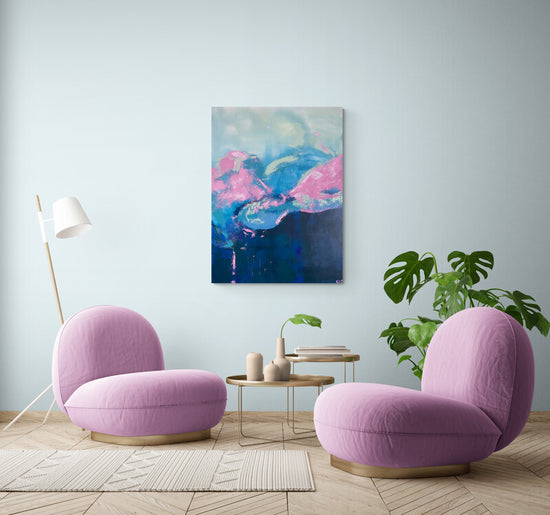
Creating a Unified Interior from Different Interior Design Styles
When it comes to interior design style, our design projects are an extension of our personalities, reflecting our unique tastes and preferences. It's a canvas where we can explore various interior design styles, decorator aesthetics, and decoration styles. However, as we delve into this world of interior design styles, we often encounter a delightful dilemma—how to harmoniously blend different styles, creating a cohesive and visually stunning living space that feels like a true reflection of our individuality.
In exploring interior design types and different interior design styles, we'll delve into the art of combining various interior design style aesthetics. We'll unlock the secrets to achieving a harmonious balance among different decor styles and discover how an eclectic interior design style can coexist with vintage elements. So, fasten your seatbelts, as we embark on a journey to answer questions like how to combine styles, understand different design styles, and ultimately, how to make your living space a masterpiece that seamlessly fuses the different design styles into one captivating whole.
Join us as we unravel the art of harmonizing diverse aesthetic preferences into one cohesive interior design style. Along the way, we'll discuss interior designer styles, interior decorating styles, and the various decoration styles that make your living space uniquely yours. Let's get started.
Understanding Diverse Aesthetic Preferences

Bohemian contemporary style interior design with natural materials and artwork by Grace Lane Smith.
No two threads are the same in the rich tapestry of interior design. Much like individual fingerprints, our tastes and preferences when it comes to interior design styles are distinct and deeply personal. This inherent diversity in our interior design style inclinations forms the very fabric of our living spaces, making them a reflection of who we are and what we love.
Each of us brings a unique perspective, influenced by our experiences, backgrounds, and interior design styles that resonate with us on a profound level. This diversity often leads to a delightful mix of interior design style aesthetics, where traditional meets modern, and rustic cozies up to sleek contemporary interior design style elements. This kaleidoscope of interior design style choices is a testament to the power of individuality and creativity in shaping our surroundings.
Now, you might wonder, "How can you achieve harmony in an interior design style that draws from such diverse sources of inspiration?" The answer lies in the art of recognizing shared values and embracing essential interior design principles. While our preferences may differ, there are universal principles that serve as the bedrock of cohesive interior design, weaving a common thread through the tapestry of our interior spaces.
As we journey deeper into the world of interior design and explore the interior design styles and types, keep in mind that your unique tastes and preferences are the raw natural materials for a unique interior design style that is truly your own. In the following sections, we'll delve into the strategies and techniques that will enable you to blend different interior decorating styles into one cohesive, visually stunning whole. So, let's embark on this creative voyage, where individuality meets unity, and interior design style becomes a delightful expression of your unique aesthetic journey.
Identifying Common Ground: Creating Design Synergy
In the realm of interior design styles and interior designer aesthetics, diversity often reigns supreme. It's a splendid tapestry of tastes and choices, each thread representing a unique perspective on interior design. However, within this captivating diversity lies a beautiful opportunity: the chance to weave together a cohesive and harmonious interior that resonates with everyone involved.
Finding Common Elements in a Sea of Styles
Imagine a canvas where each stroke of colour represents an interior design style preference, from modern interior design style to timeless vintage charm. The challenge, then, becomes not in erasing these strokes but in discovering the common hues and bold patterns that can bind them together. In essence, it's about identifying those shared elements, be it a love for clean lines, a passion for vibrant colours, or an appreciation for natural textures.
This process of identifying common ground is akin to finding the keynotes in a symphony of interior design styles. It's about recognizing that amidst the diversity, there are unifying themes and ideas that can guide your interior design style journey.
Open Communication and Collaborative Creation
But how do you unearth these common threads? Here's where open communication and collaboration play pivotal roles. In the world of interior design, stakeholders come together with their own interior design style aspirations, whether it's a homeowner with a penchant for modern interior design style or a family member drawn to traditional decor styles.
Encouraging a space where ideas flow freely and stakeholders feel heard is vital. It's a collaborative endeavor, where each voice contributes to the evolving interior design style narrative. Through open dialogue, you can uncover the desires and preferences that resonate across the board, creating a shared vision for your interior.
Shared Values: The Foundation of Cohesion
 Natural materials decorating style with "Epoch 1" painting by Danielle Petti
Natural materials decorating style with "Epoch 1" painting by Danielle Petti
Now, you might wonder how these shared elements and collaborative discussions translate into a cohesive interior design. The answer lies in the shared values that emerge during this process. It's not merely about finding similar decor styles but understanding the underlying principles that drive those preferences.
These shared values become the foundation upon which your cohesive interior design style is built. They guide decisions about colour palettes, furniture choices, and decor elements. Whether it's a shared love for sustainability, a commitment to functionality, or an affinity for a specific colour scheme, these values act as the compass, directing your interior design style choices toward a unified whole.
In this journey of identifying common ground, we unlock the potential for interior design style synergy, where diverse interior design styles and aesthetics blend harmoniously. It's about celebrating individuality while fostering unity, a beautiful dance between unique preferences and shared values. As we continue this exploration of interior design styles and decor styles, keep these principles in mind, for they are the stepping stones toward a truly cohesive and captivating interior.
Creating a Mood Board: Visualizing Harmony in Interior Design Styles
In the enchanting world of interior design styles and decoration aesthetics, sometimes words alone fall short of conveying the full spectrum of our creative visions. This is where the art of creating a mood board steps in, serving as a visual compass that guides us through the intricate process of harmonizing diverse interior design styles.
Unveiling the Magic of Mood Boards
So, what exactly is a mood board, and how does it relate to combining different decorating styles into a cohesive whole? Think of it as a dynamic collage, a canvas where you can artistically arrange and juxtapose elements from various interior design styles. It's a powerful tool that transcends language, enabling you to communicate your interior design style aspirations clearly and vividly.
Crafting a Cohesive Visual Narrative
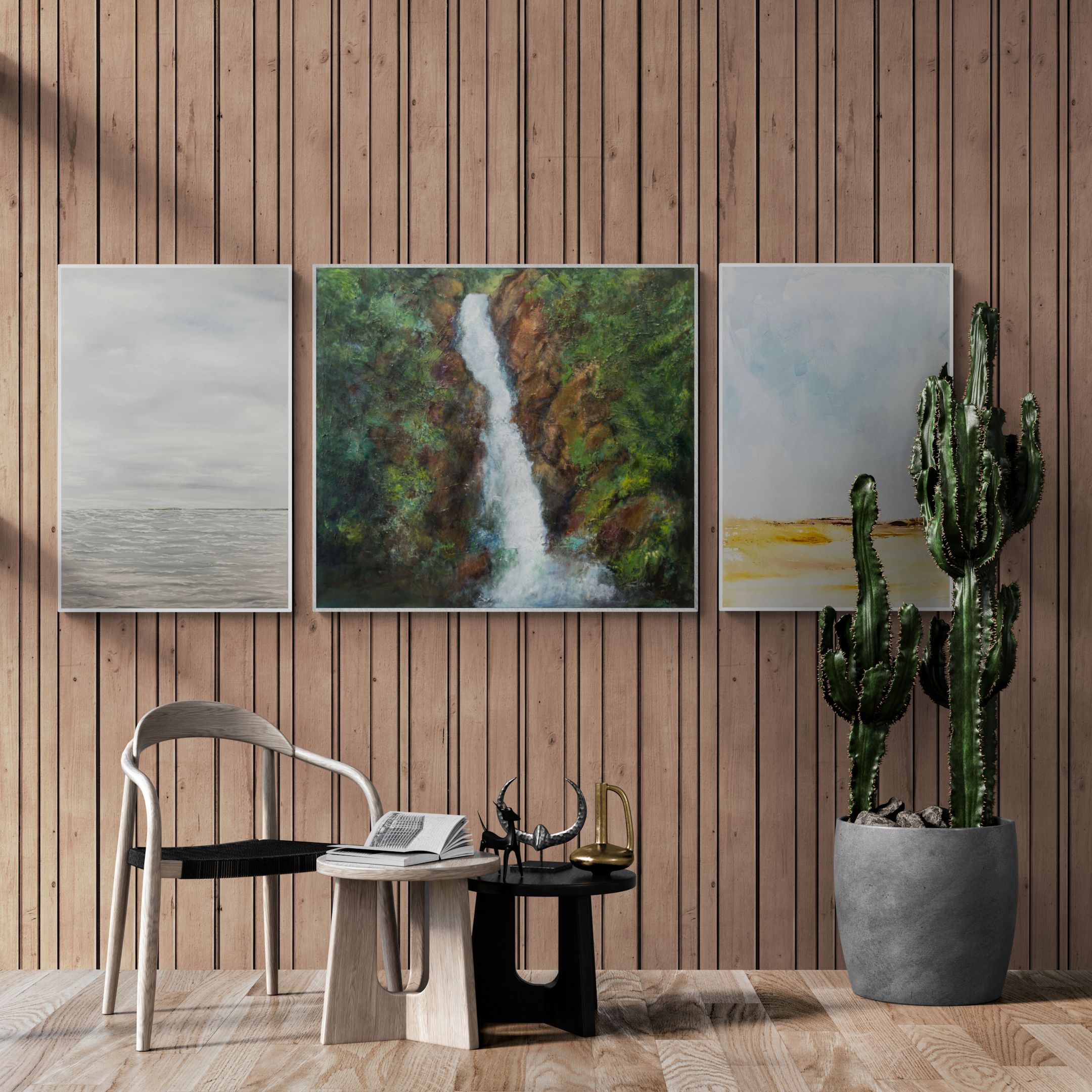
A personal style inspired by landscapes with paintings by Sophie Yeh-Chau and Christine Viens from the Artterra.
To create a mood board that captures the essence of your envisioned interior design, start by gathering inspiration from interior design styles and decorator aesthetics. Explore magazines, online platforms, or even your own photographs for elements that resonate with you. These could range from the sleek lines of modern interior design styles to the rustic charm of traditional decor styles.
Now, here's where the magic happens: mix and match. Select key pieces, colour palettes, textures, and bold patterns that represent the diverse interior design styles you aim to combine. Place them on interior designer mood board like pieces of a puzzle, weaving a narrative that seamlessly blends these natural elements. It's the place where contemporary design style meets vintage, minimalism dances with maximalism, and every element finds its harmonious place.
The Mood Board's Role in Combining Decorating Styles
An interior designer might wonder how this visual creation aids in combining decorating styles for a cohesive look. Well, the beauty of a mood board lies in its ability to provide a holistic view of your interior design style concept. It allows you to step back and evaluate how interior design styles interact on a single canvas.
When you can see these styles side by side, it becomes easier to identify common themes, shared colour palettes, or unexpected synergies. It acts as a tangible bridge between your individual interior designer preferences and the goal of achieving a unified interior design. The mood board becomes a roadmap, guiding you toward choices that harmonize diverse interior design styles, transforming them into a single, coherent masterpiece.
As we journey further into the realm of interior design style and delve into ways of mixing interior design styles, remember the role of the mood board as your visual storyteller. It's your tool for translating the abstract into concrete, creating a design style vision that brings together the richness of diverse decorating styles into a captivating and cohesive narrative.
Balancing Key Interior Design Elements: The Art of Harmonious Interior Styles
In the captivating world of interior design, where different interior design styles and decorator aesthetics converge, the art of balance becomes paramount. Successfully harmonizing these diverse elements requires a keen understanding of fundamental design principles like colour, texture, pattern, and scale. Let's dive into the intricacies of achieving this design style synergy while answering the question: "How can you, the interior designer, achieve harmony in a design?"
The Palette of Possibilities: Colors in Harmony
 Colourful gallery wall style with paintings from artterra artists
Colourful gallery wall style with paintings from artterra artists
Colour, often the most expressive element of design, can bridge the gap between disparate interior design styles. A smart starting point is selecting a neutral colour palette that forms the backdrop of your design style canvas. Neutrals like whites, grays, and beige provide a serene foundation that transcends specific style preferences, allowing different design styles to coexist effortlessly.
Now, consider accent colours. These are your interior designer brushstrokes of personality. Whether it's a bold pop of colour inspired by interior design style or earthy tones reminiscent of rustic decor styles, these accents infuse character into your space. The key is to strike a balance—think of your colour palette as a symphony, where every shade plays a unique role, contributing to the overall harmony.
Textures and Patterns: Adding Depth and Intrigue
Texture and pattern are the spice of interior design, breathing life into your space. They offer an opportunity to infuse contrasting interior design styles with a delightful tactile and visual appeal. For instance, the clean lines of interior design style can be enriched with the warmth of natural wood textures or the coziness of plush textiles inspired by traditional decor styles.
The interplay of textures and bold patterns adds depth and intrigue to your interior, making it visually engaging. Picture a sleek, minimalist sofa adorned with vibrant, patterned throw pillows—this juxtaposition of elements exemplifies the art of blending different interior design styles while maintaining a cohesive look.
Interior Design Principles: Balance, Rhythm, Contrast
 Artwork collection on natural light display
Artwork collection on natural light display
with paintings from artterra artists, Pamela Paulenko, Melodie Mui, and Rachel Marie.
As we consider the question of achieving harmony in an interior design style that combines various aesthetics, it's essential to delve into the core design principles: balance, rhythm, and contrast. These principles are the guiding stars that navigate the complexities of interior design.
Balance ensures that no single element dominates the space. It's the equilibrium between different interior design styles, where neither overshadows the other. In the dance of styles, balance is your choreographer, ensuring each move complements the next.
Rhythm infuses your interior design style with a sense of continuity. It's the repeating motifs, colours, or shapes that create a visual beat, leading the eye through the space. Rhythm weaves together the disparate elements into a cohesive narrative.
Contrast is the element of surprise, the spice that adds interest to your interior design. It's the interplay of light and dark, smooth and rough, simple and ornate. Contrast is your storyteller, creating moments of drama within the harmony.
In the symphony of interior design, mastering the balance of key design elements is the conductor's wand that ensures every note harmonizes, even when drawing from different design styles. So, remember the power of colour, texture, pattern, and the timeless principles of balance, rhythm, and contrast as you embark on your journey to create a unified and captivating interior.
Utilizing Design Principles: The Glue That Binds Diverse Styles
When navigating the intricate world of interior design styles and decoration aesthetics, it's essential to understand that beyond the surface allure, there are timeless design principles at play. These principles—balance, rhythm, and contrast—serve as the secret sauce that unifies diverse preferences, transforming your space into a harmonious symphony of style. In this section, we'll delve into the practical applications of these principles while addressing the question of "How can you achieve harmony in a design?"
Balancing Act: Creating Equilibrium
Particular style with an eclectic design, brought together by Kateryna Kobylianska's painting
Balance is the anchor that prevents your design style from veering into chaos. It's the equilibrium between different design styles, where neither overshadows the other. Consider a room where a grand, traditional chandelier graces the ceiling, and sleek, contemporary design style furniture adorns the floor. This juxtaposition could be visually jarring without balance.
To achieve balance, ensure that the weight of elements on one side of your design style is counteracted by elements on the other. For example, balance a bold, modern statement piece with a softer, more traditional counterpart. The result is a room where the two design styles coexist in harmony, each lending its unique charm without overpowering the other.
Creating a Rhythmic Flow
Interior design project with wall art 'Basquiat' by Helen Una George
Rhythm infuses your interior design style with a sense of continuity, akin to the steady beat of a drum. It's the repeating motifs, colours, or shapes that guide the eye seamlessly through your space. Whether your design style leans towards an interior design style or a more eclectic mix, rhythm brings order and coherence.
To establish a rhythm, introduce recurring elements throughout your interior design style. This could be a repeating colour scheme, a consistent use of natural materials, or even a recurrent pattern. By maintaining these design rhythms, you create a visual flow that connects diverse elements, making your space feel cohesive and inviting.
The Drama of Contrast
Painting by Aly McDonald, creates a unique Interior design style with bold colours and textures.
In the grand theatre of interior design, contrast is the element that adds drama and intrigue to your composition. It's the interplay of natural light and dark, smooth and rough, simple and ornate. Like a well-written script, contrast creates moments of tension and release within your interior design style, keeping it engaging.
To utilize contrast effectively, consider elements like colour, texture, or scale. For instance, a minimalist, monochromatic room can be invigorated by bold, colourful artwork or a textured accent wall inspired by rustic decor styles. The stark difference between the minimalism and the contrasting element elevates the design and adds depth.
Mixing Furniture and Decor: A Symphony of Styles
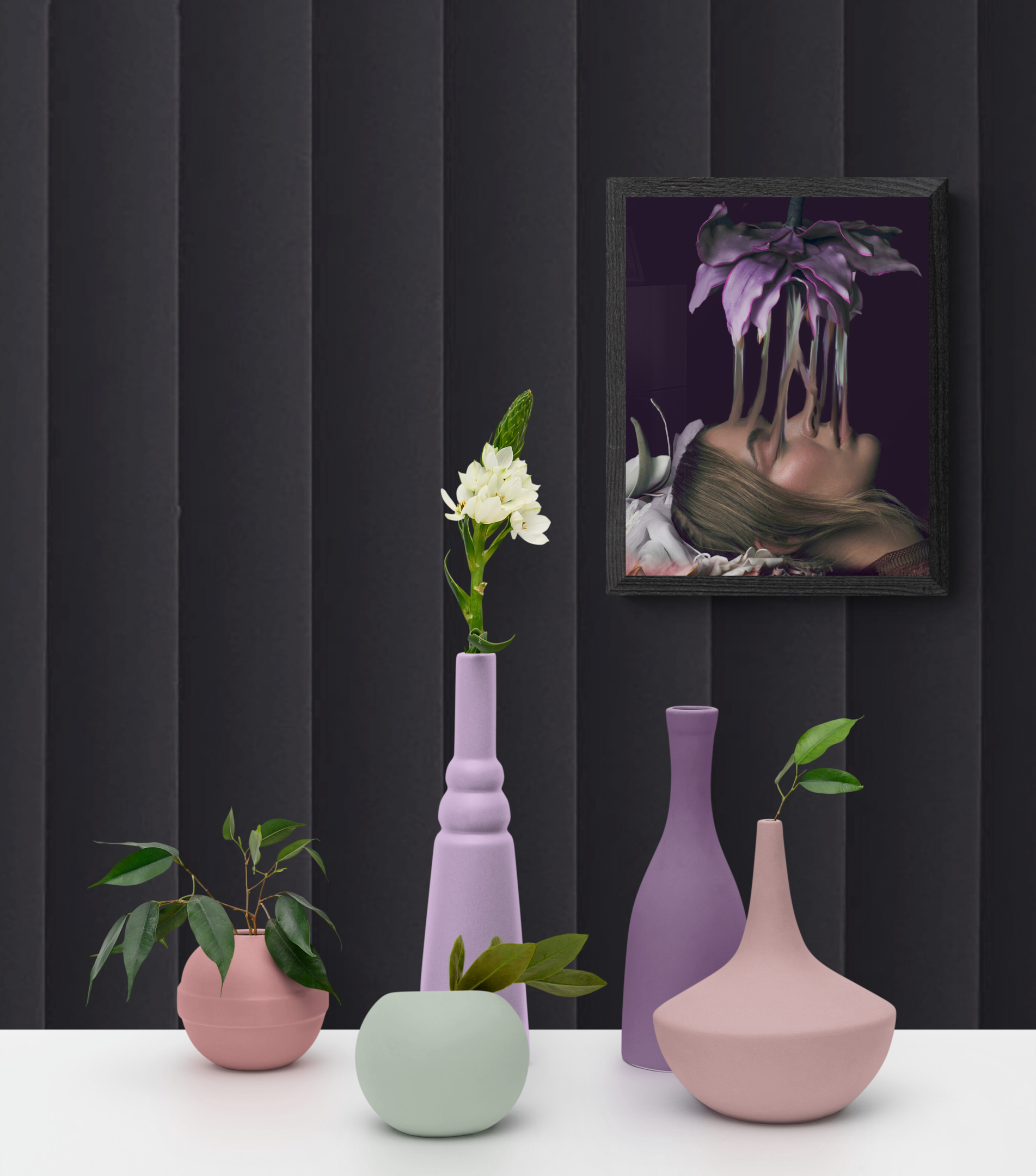
A mix of different colourful decor styles with wall art painting by Chahat Soneja.
In the grand composition of interior design styles and decoration aesthetics, one of the most exhilarating movements is the art of blending different furniture styles and decor elements. It's here that diverse design preferences harmonize, where the past meets the present, and where unique or sentimental pieces find their place in the symphony of style. Join us as we explore the strategies for achieving this captivating design cohesion while addressing the question: "How do you mix two design styles?"
Blending Furniture Styles for Cohesion
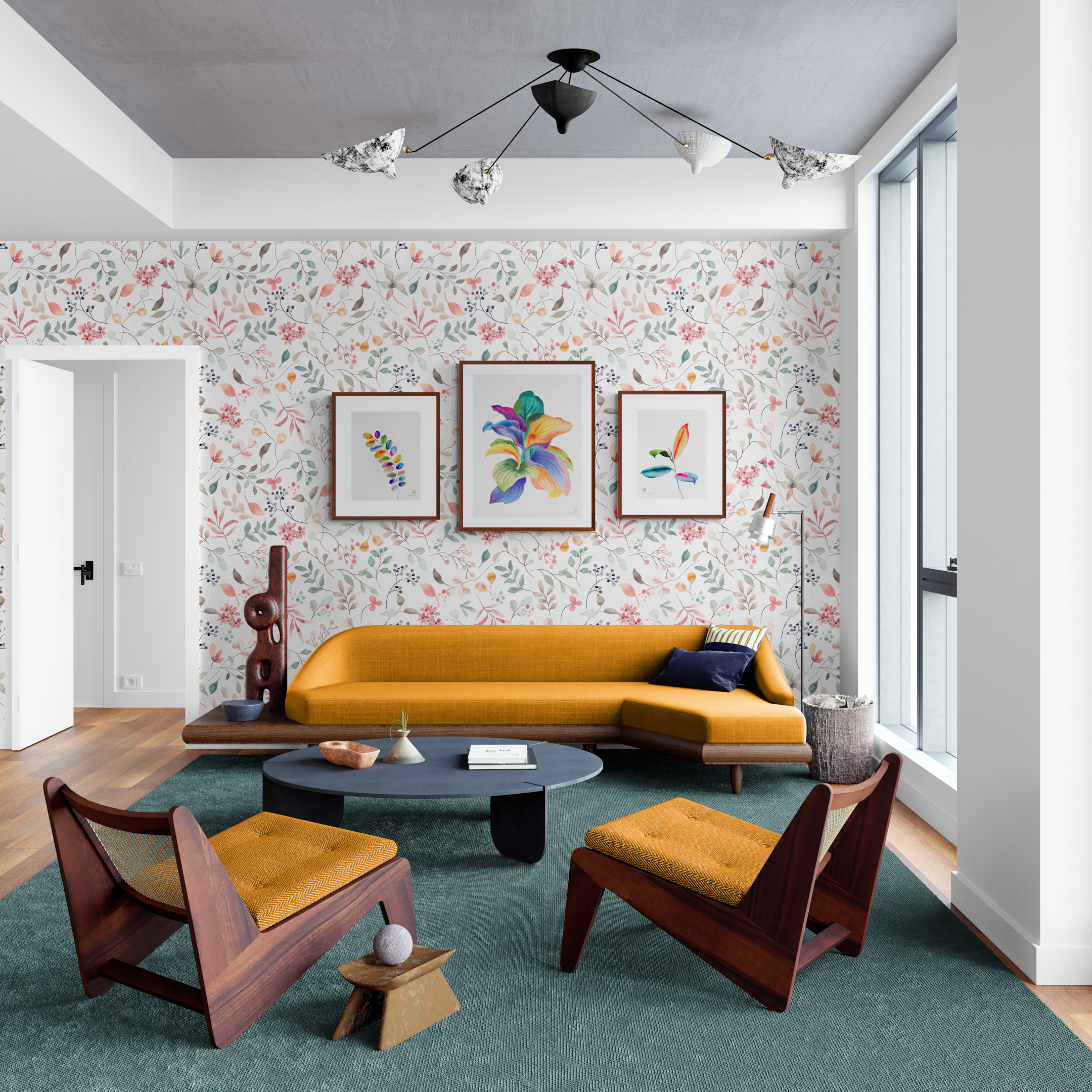
An Interior style with unique light fixtures curated by interior designers. Paintings on the wall are by artterra artist, Xiao Wen Xu.
Furniture, the backbone of any interior, has the potential to unify or divide different popular interior design styles. To create a cohesive look that seamlessly melds various aesthetics, start by identifying commonalities in form, function, or natural materials. This could mean selecting pieces with similar silhouettes, such as clean lines and minimalistic profiles, reminiscent of modern interior design style.
Consider a dining room where a sleek, contemporary table pairs harmoniously with classic, upholstered chairs. The contrast in styles becomes a source of visual intrigue while the shared element of neutral upholstery bridges the gap, creating a balanced and unified ensemble.
Preserving Sentiment and Style
For those cherished, unique, or sentimental pieces that hold a special place in your heart, finding a role for them in your evolving interior can be a delightful challenge. These pieces tell stories, encapsulating memories and personal narratives. When blending them into your interior design style, consider them as the highlights in your composition, akin to a soloist in an orchestra.
For instance, a vintage heirloom dresser with intricate detailing can coexist beautifully with a minimalist, contemporary bedroom design. The juxtaposition of old and new adds character and depth, creating a space that is as unique as your personal story.
Successful Furniture and Decor Combinations
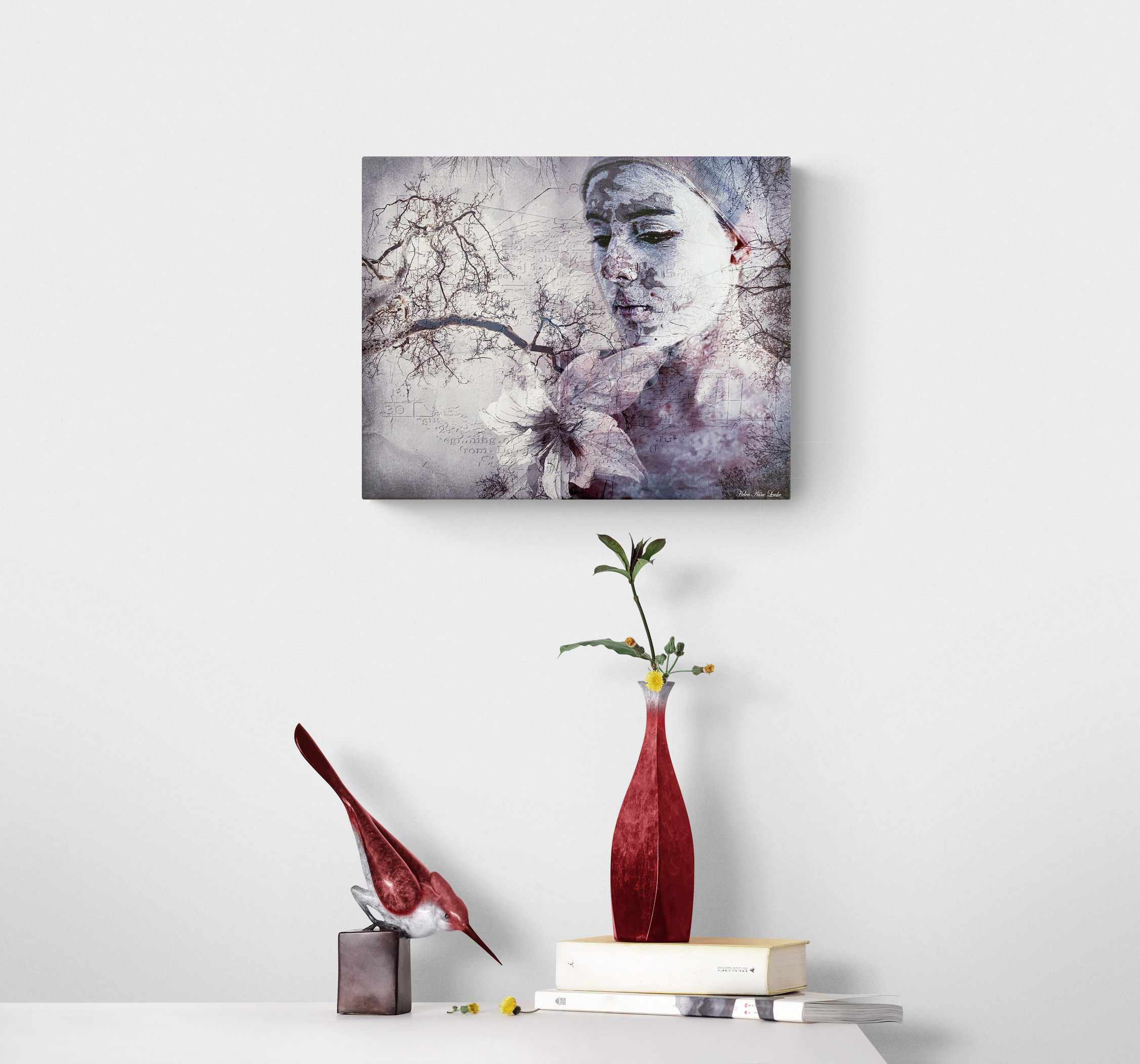
A unique collection of home decor with "Pondering" by Helen Anne Lemke.
Now, let's address the heart of the matter: How do you mix two design styles successfully? The key lies in selecting pieces that complement, rather than clash with, each other. Picture a living room where a plush, velvet Mid-Century Modern sofa sits alongside a sleek, glass-topped coffee table inspired by modern interior design.
This combination thrives on balance. The sofa provides softness and texture, while the coffee table introduces a touch of contemporary elegance. The result is a captivating blend of interior design styles that feels harmonious and visually striking.
In the intricate ballet of mixing furniture and decor styles, consider your interior as a canvas waiting to be painted. Each piece you introduce is a brushstroke, contributing to the larger masterpiece. It's the careful selection of pieces, the recognition of shared elements, and the preservation of personal stories that allow you to achieve a cohesive and captivating design that seamlessly blends different design styles.
Before-and-After: The Proof in the Pudding
To truly grasp the transformative power of these design principles, let's turn our attention to before-and-after examples. Picture a room where diverse design preferences have resulted in a cluttered, disjointed space. By applying the principles of balance, rhythm, and contrast, you can witness the dramatic change as the chaos gives way to harmony.
In the 'before,' the room may be a cacophony of competing styles and conflicting elements. However, through the careful application of these principles, the 'after' reveals a space where different design styles not only coexist but elevate each other, resulting in a harmonious and visually striking interior.
In summary, the utilization of design principles like balance, rhythm, and contrast is the alchemy that transforms your design from a collection of disparate elements into a unified masterpiece. By understanding these principles and applying them practically, you unlock the potential to harmonize diverse design preferences and create a space that not only pleases the eye but also tells a captivating design story.
Customizing and Personalizing: Your Signature on Interior Styles
In the rich tapestry of interior design styles and decorator aesthetics, one element stands as the true hallmark of a well-crafted living space—personalization. The ability to infuse your unique style and personality into your home is what transforms it from a mere arrangement of elements into a living, breathing reflection of who you are. In this section, we'll emphasize the importance of personalization in interior design while sharing design ideas that weave your individuality into the very fabric of your space.
The Power of Personalization
Imagine walking into a room and feeling an immediate sense of connection, as if the space were designed exclusively for you. This is the magic of personalization in interior design—a process that transcends the boundaries of different design styles and interior decorating styles to create an environment that is uniquely yours.
Personalization isn't just about selecting from the myriad of interior design types or adhering to specific decor styles. It's about curating a space that resonates with your soul, where every element feels purposeful and meaningful. Whether your heart gravitates towards modern interior design or you find solace in the embrace of traditional decor styles, personalization is the thread that weaves your preferences into the tapestry of your space.
Adding Your Personal Touch
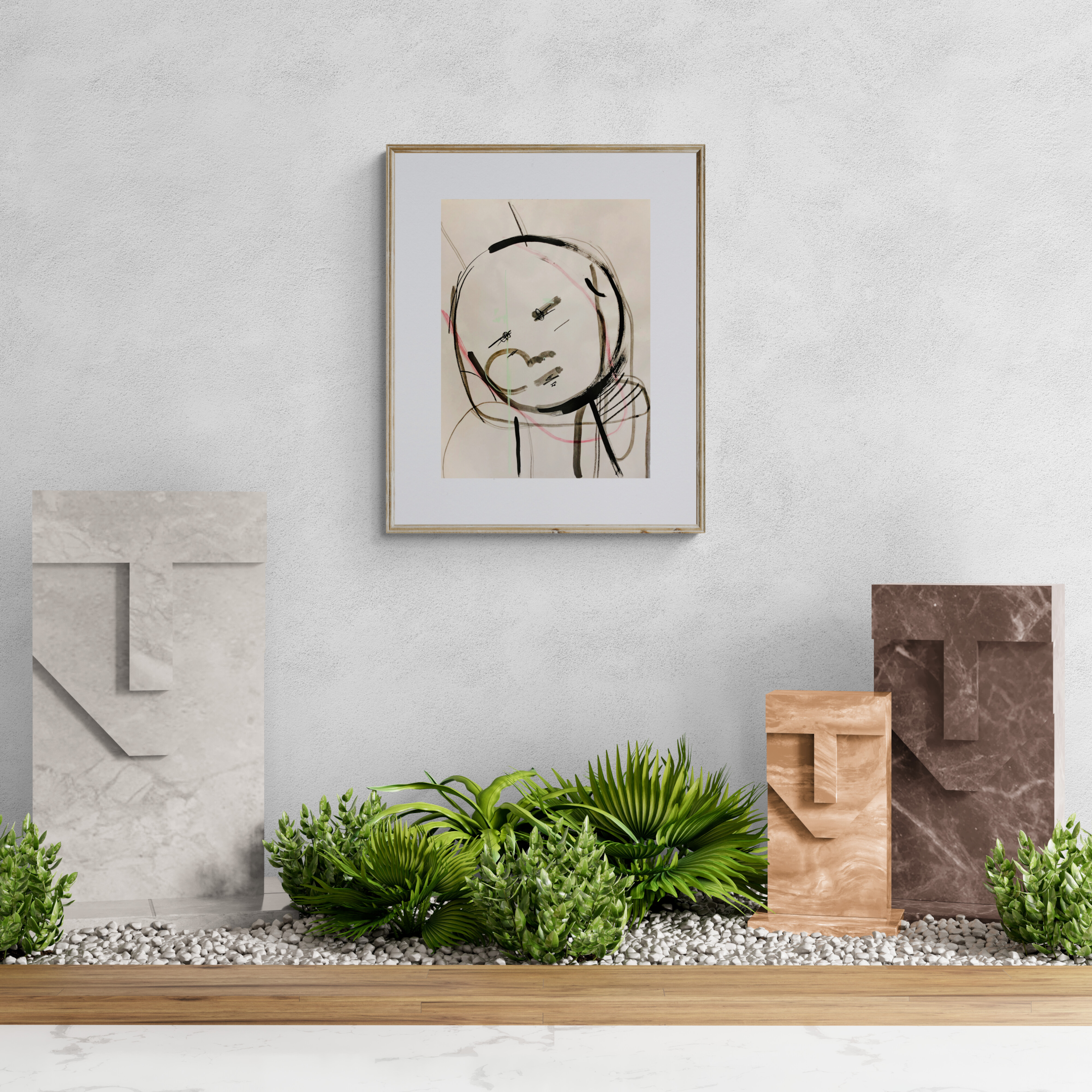
A Unique interior garden with wall art by Liz Wurzinger.
To begin your personalization journey, consider the vast array of possibilities for incorporating elements that speak to your individuality. Here, the possibilities are as diverse as the different decor styles themselves.
Artwork: Adorn your eclectic interior design style with artwork that reflects your passions and interests. Whether it's a collection of contemporary pieces in line with modern interior design or classic portraits in harmony with traditional decor styles, your choice of art tells a story.
Family Photos: Display cherished family photos, creating a gallery that celebrates your most cherished moments. Arrange them in frames that resonate with your interior design aesthetics, whether that's sleek and modern or warm and rustic.
DIY Projects: Engage in interior design DIY projects that add a personal touch. Craft your own art or create custom shelving that integrates seamlessly with your chosen design styles.
Textiles: Choose textiles like rugs, curtains, and cushions that align with your interior decorating styles. The texture and colour of these elements can transform a room, reflecting your preferences.
Unique Collectibles: Showcase unique collectibles or souvenirs that hold sentimental value. These objects can be conversation pieces that infuse character into your space, irrespective of your chosen interior design types.
By incorporating personal elements like these into your interior, you transform your living space into a narrative—a story of your life, passions, and design preferences. Your home becomes a canvas where different design styles converge and where personalization is the unifying brushstroke that ties them all together.
In the world of interior design, the beauty lies in the blend—different decor styles, different design types, mixed styles, and decor elements all come together under the umbrella of your unique taste and personality. It's the interplay of personalization and design aesthetics that creates an interior that feels truly yours, a space where you are not just an observer but an active participant in the design journey. So, embrace the power of personalization, and let your interior styles speak your language, tell your story, and reflect your soul.
Flexibility and Adaptation: Navigating the Ever-Evolving Design Journey
In the captivating realm of interior design styles and decoration aesthetics, one thing is certain: design is not a static destination but a dynamic journey. It's a journey that evolves, unfurls, and transforms as you navigate through different design styles, interior designer aesthetics, and interior decorating styles. In this section, we'll highlight the importance of flexibility and adaptation while ensuring that cohesion remains at the heart of your design voyage.
Embracing the Evolution of Design
 Eclectic interior design style with a collection of Artterra paintings by Helen Una George and Christopher Barnabe
Eclectic interior design style with a collection of Artterra paintings by Helen Una George and Christopher Barnabe
Think of your interior design style journey as a story, one that unfolds chapter by chapter. Each chapter represents a new phase, a fresh perspective, or an evolving inspiration. The different decor styles and interior design types that have guided you thus far are essential components of this narrative.
Design is, by nature, a fluid and evolving process. The tastes and preferences that influence your design choices today may shift tomorrow, much like the ebb and flow of design styles. Whether you are drawn to the crisp lines of modern interior design or the timeless allure of traditional decor styles, it's crucial to embrace the evolving nature of design.
Flexibility as Your Guiding Star
As you progress through your design journey, one of the key attributes you must cultivate is flexibility. It's the ability to pivot, adapt, and evolve your design vision in response to changing preferences, new inspirations, or life's evolving circumstances.
Flexibility means being open to the possibility that your interior design styles and decorator aesthetics might shift. It means recognizing that what resonated with you yesterday may not hold the same allure today. It's about being unafraid to explore different interior design styles, mix styles, or incorporate elements inspired by modern interior design, even if your journey began with a different perspective.
Adapting Without Compromising Cohesion
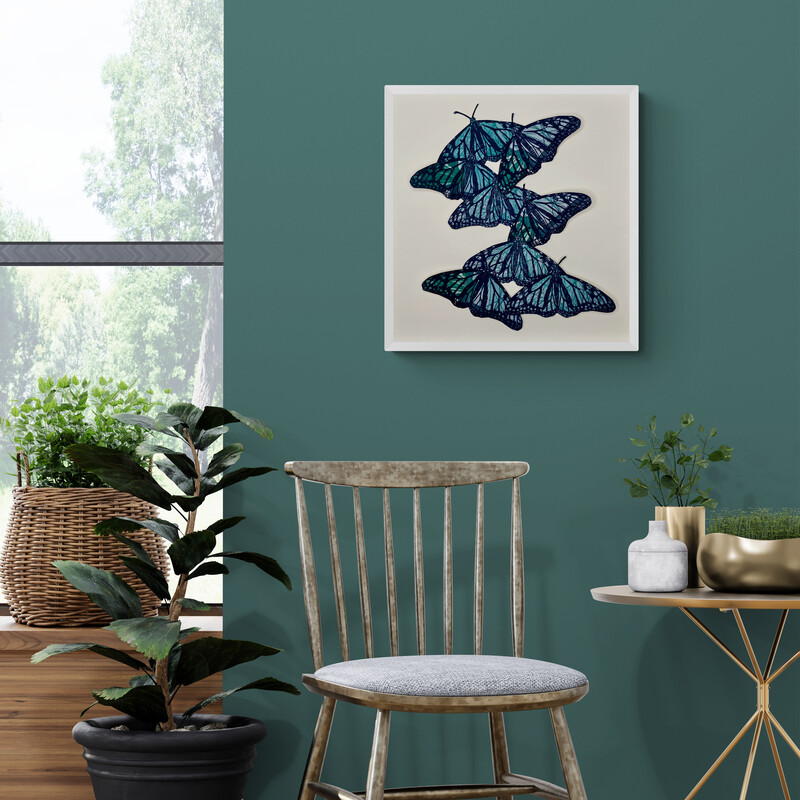
Teal and green decorating style complemented with natural materials and modern elements with wall art by artterra artist, Lorna Livey.
Now, how do you maintain cohesion in your design while embracing flexibility and adaptation? The key lies in your foundational elements—the shared values, design principles, and common elements that you've identified in the earlier phases of your journey.
Even as your design evolves, these foundational elements act as your guiding stars, keeping your interior rooted in cohesion. For instance, if you started with a rustic decor style but now find yourself drawn to modern interior design, you can seamlessly incorporate contemporary elements without losing the rustic charm. The shared elements—perhaps a love for natural materials or a preference for warm earth tones—serve as the bridge that unites diverse design styles.
In essence, your design journey is a tapestry where different styles and interior design types weave in and out, each adding a layer of richness to your narrative. By remaining flexible and open to adaptation, you allow your design to breathe and grow, ensuring that it remains a reflection of your evolving tastes and the ever-evolving landscape of design styles.
As you continue on your design journey, remember that it's not about adhering to a single interior design aesthetic but about crafting a space that is authentic, dynamic, and uniquely yours. Embrace the beauty of design evolution, and let it be a testament to your ever-evolving taste and style.
Conclusion
In our exploration of interior design, we've discovered the art of harmonizing diverse preferences into one cohesive interior design. Embracing the uniqueness of individual aesthetic preferences is the first step towards creating a space that truly reflects your identity.
We've celebrated the importance of finding common ground, using mood boards to blend styles seamlessly, and applying design principles like balance, rhythm, and contrast to bring harmony to our spaces. We've also learned how to mix furniture and decor styles, incorporate personal touches, and remain flexible in our design journey.
As we conclude this journey, remember that your living space is a canvas for self-expression, and each element you add tells your unique story. Feel free to share your experiences, insights, and questions in the comments below, and let's continue to unravel the intricacies of harmonizing diverse aesthetic preferences in interior design. Thank you for joining us on this creative odyssey.

